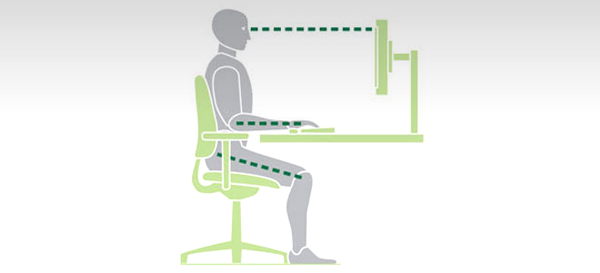Good task chairs are designed to be adjusted for personal comfort. Here is how to make these adjustments to set up a desk chair in seven simple steps:
- Height. Sit with your bum pushed back into your chair and feet flat on the floor. Adjust the seat height so that your hips are just above your knees. If you are sway-backed, then this might be a bit more; the aim is to have your back in a position as if you are standing. Don’t worry about the desk height – that comes later.
- Seat adjustments. Slide the seat forwards/backwards until you have three fingers’ width between the end of the seat and the back of your knee. Some chair seats have the ability to be tilted. If so, tilt the seat to support your position (after doing so you may need to slightly adjust the seat height).
- Back/lumbar support. Adjust the back height/lumbar support up or down so that the most pronounced part fits into the small of your back.
- Back angle and dynamic tilt. Sometimes you will need to be forward looking at your computer. Other times you will lean back, e.g. when you are on the phone. Adjust to suit throughout the day or, better, let it move so that your back stays active throughout the day, with the support tension adjusted so that your muscles work evenly on the front and back of your core.
- Arm rests. These should be just under your elbows when they are relaxed at your side. If they are higher then you will automatically hunch your shoulders – leading to back stress.
- Desk height. When your hands are on the keyboard they should be slightly below your elbows. Otherwise you will instinctively hunch your shoulders to pull them up. Hopefully your desk will be height adjustable so you can raise/lower it to suit. If not and the desk is too high, use a footrest and lift up your chair a corresponding amount. If the desk is too low then use your old accounting/chemistry/self-help books to chock it up – finally they can be useful. Or there are some handy feet that can be purchased to raise desk height.
- Seek professional help. The above advice is generic; individuals may have specific needs requiring advice from an ergonomist. They can set up a desk chair to suit your needs. Listen to your body – it will let you know if the setup is wrong.
More tips and advice to create a great office are available at the Rype Office Blog, dedicated to creating beautiful, budget-friendly, productive and sustainable offices.
Disclaimer: This article is not to be construed as medical advice.

